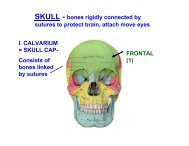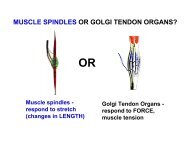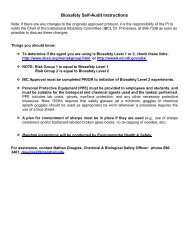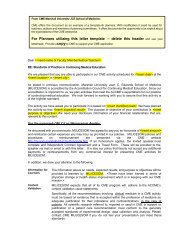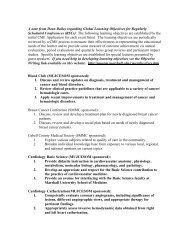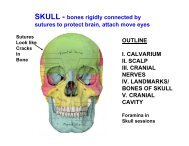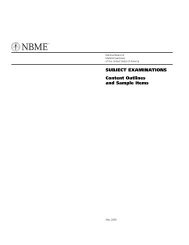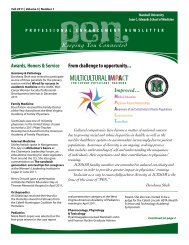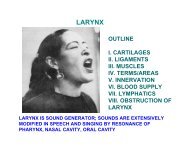FA 5 Progress Report WV-INBRE - Joan C. Edwards School of ...
FA 5 Progress Report WV-INBRE - Joan C. Edwards School of ...
FA 5 Progress Report WV-INBRE - Joan C. Edwards School of ...
- No tags were found...
Create successful ePaper yourself
Turn your PDF publications into a flip-book with our unique Google optimized e-Paper software.
Program Director/Principal Investigator (Last, First, Middle): Rankin, Gary O 77dehydrogenase (LDH) leakage within 120 min exposure. RES totally prevents LDH leakage bycisplatin and establishes that RES prevents cisplatin renal cytotoxicity.Changes occurring in pathways prior to LDH leakage would suggest a role in the mechanism <strong>of</strong>toxicity. RES does prevent cisplatin mediated depletion <strong>of</strong> Manganese Superoxide Dismutase(MnSOD) activity. Maintenance <strong>of</strong> Mn SOD by RES would allow for continued detoxification <strong>of</strong>superoxide anions (O2-) and diminished oxidative stress that is associated with cisplatin exposure<strong>of</strong> renal tissue. New methods were established in our laboratory to examine Cu-Zn SOD andcatalase enzyme activity. We have also helped Dr. Hardman’s laboratory establish these assaysfor studies conducted by one <strong>of</strong> her graduate students. The results from our studies show thatcatalase enzyme activity is diminished by cisplatin. However, renal tissue in the presence <strong>of</strong> RESexposure to cisplatin did not demonstrate as extensive a decline in catalase activity.Oxidative stress is a relative balance <strong>of</strong> antioxidant enzymes. A decline in MnSOD can result inaccumulation <strong>of</strong> O2- and increased oxidative stress. However, if cisplatin induced a greater declinein catalase then oxidative stress can be more magnified as the product <strong>of</strong> MnSOD action, H2O2will not be detoxified and can induce cytotoxicity. Our result suggests that RES decreases oxidativestress by cisplatin by maintaining a more favorable balance between MnSOD and catalase.Our in vitro studies have shown that depletion <strong>of</strong> glutathione by cisplatin is not prevented by RES.Therefore, the mechanism for RES attenuation does not involve prevention <strong>of</strong> glutathione depletion.Initial studies examining mitochondrial swelling also suggest that RES does not act by preventingmitochondrial swelling induced by cisplatin. Further studies need to evaluate longer periods <strong>of</strong> timewith mitochondrial exposure. A time dependent study has shown extensive modulation by RES <strong>of</strong>oxidative stress induced by cisplatin. RES prevents cisplatin oxidative stress 60 min prior toinduction <strong>of</strong> LDH leakage. These studies suggest a RES greatly diminishes oxidative stress. Moreimportantly, the decline in oxidative stress occurs prior to LDH leakage.In vivo studies: We have conducted in vivo cisplatin renal toxicity studies between 6-72 h postcisplatin. Renal function will be analyzed by urinary protein excretion as a function <strong>of</strong> time.Qualitative analysis has shown no increase in urinary glucose and therefore urinary glucoseexcretion will not be analyzed. Cisplatin renal toxicity is assessed by kidney to body weight ratios,blood urea nitrogen (BUN) levels and histological evaluation by light microscopy. Our laboratory hasestablished a new method for BUN measurement using a microtiter assay. This method is nowestablished in our laboratory and can be used by other investigators.Pharmacokinetic studies: RES may reduce cisplatin renal toxicity by: a) increasing cisplatin renalclearance or b) diminishing cisplatin renal tissue accumulation. Experiments have been completedto evaluate the pharmacokinetic interaction <strong>of</strong> RES and cisplatin. Male F344 rats were placed inmetabolism cages. Parameters evaluated in metabolism cages include food and water intake, bodyweight, urine volume and urine protein. Rats were randomly divided into the following groups:Vehicle (DMSO and water), RES, Cisplatin (5 mg/kg, ip) and RES+Cisplatin. RES was injected 30min prior to cisplatin. Plasma and renal tissue was collected 6, 24, 48 and 72 h after cisplatininjection. Urine was collected on ice Pt analysis at the following time points: 0-6 h, 6-24 h, 24-48 h.Pt is analyzed instead <strong>of</strong> cisplatin for all published pharmacokinetic studies. Samples will be aciddigested and then analyzed by Dr. Troyer. The Pt analysis should be completed by July 2012.PersonnelTwo undergraduate students work part-time in my laboratory as research student assistants. Theirnames are Michael Wright and Bekkah Brown and these students work a maximum <strong>of</strong> 20 hoursper week. A Master’s level graduate student, Jacob Wolfe was hired in January 2012 and he worksa maximum <strong>of</strong>20 hours per week. All <strong>of</strong> these students have become pr<strong>of</strong>icient at HPLC samplePHS 2590 (Rev. 06/09)Continuation Format Page



